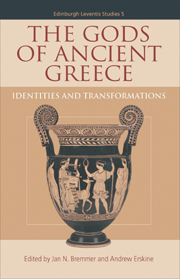Book contents
- Frontmatter
- Contents
- Preface
- List of Illustrations
- Notes on Contributors
- List of Abbreviations
- Introduction: The Greek Gods in the Twentieth Century
- 1 What is a Greek God?
- PART I SYSTEMATIC ASPECTS
- 2 Canonizing the Pantheon: the Dodekatheon in Greek Religion and its Origins
- 3 Gods in Greek Inscriptions: Some Methodological Questions
- 4 Metamorphoses of Gods into Animals and Humans
- 5 Sacrificing to the Gods: Ancient Evidence and Modern Interpretations
- 6 Getting in Contact: Concepts of Human–Divine Encounter in Classical Greek Art
- 7 New Statues for Old Gods
- PART II INDIVIDUAL DIVINITIES AND HEROES
- PART III DIACHRONIC ASPECTS
- PART IV HISTORIOGRAPHY
- Epilogue
- Index
2 - Canonizing the Pantheon: the Dodekatheon in Greek Religion and its Origins
from PART I - SYSTEMATIC ASPECTS
Published online by Cambridge University Press: 05 August 2013
- Frontmatter
- Contents
- Preface
- List of Illustrations
- Notes on Contributors
- List of Abbreviations
- Introduction: The Greek Gods in the Twentieth Century
- 1 What is a Greek God?
- PART I SYSTEMATIC ASPECTS
- 2 Canonizing the Pantheon: the Dodekatheon in Greek Religion and its Origins
- 3 Gods in Greek Inscriptions: Some Methodological Questions
- 4 Metamorphoses of Gods into Animals and Humans
- 5 Sacrificing to the Gods: Ancient Evidence and Modern Interpretations
- 6 Getting in Contact: Concepts of Human–Divine Encounter in Classical Greek Art
- 7 New Statues for Old Gods
- PART II INDIVIDUAL DIVINITIES AND HEROES
- PART III DIACHRONIC ASPECTS
- PART IV HISTORIOGRAPHY
- Epilogue
- Index
Summary
It is surprising that an idea apparently so central to Greek religion as the twelve gods or Dodekatheon can be traced back no further than the late sixth century BC. This is when an altar of the twelve gods was set up in the agora at Athens by the archon Peisistratos, son of Hippias, and grandson of Peisistratos the tyrant, in 522 BC, during the regime of Hippias. It was a modest, square structure, situated in the northwest corner of the agora, discovered during the construction of the Athens–Piraeus railway, and now bisected by it. The altar of the twelve gods was the symbolic centre of the city: in one of his Dithyrambs for Athens (fr. 75) Pindar calls on the gods who come to the ‘incense-rich navel in holy Athens and the glorious, richly adorned agora’, on the occasion of the ritual reception of Dionysos there at the Dionysia festival. The striking word ‘navel’ (ὀμφαλός) suggests Delphi, the navel-stone and exact centre of the earth, where two eagles let go from the East and the West met. Distance was measured from the Athenian altar: Herodotus (2.71.1) points out that the distance from the city of Heliopolis in Egypt to the Mediterranean Sea was almost exactly the same as that from the altar of the twelve to Olympia. A verse inscription from the fifth century specifies the distance from the altar of the twelve to the Peiraeus. One gets a glimpse of a well-organized measuring system.
- Type
- Chapter
- Information
- The Gods of Ancient GreeceIdentities and Transformations, pp. 43 - 54Publisher: Edinburgh University PressPrint publication year: 2010



